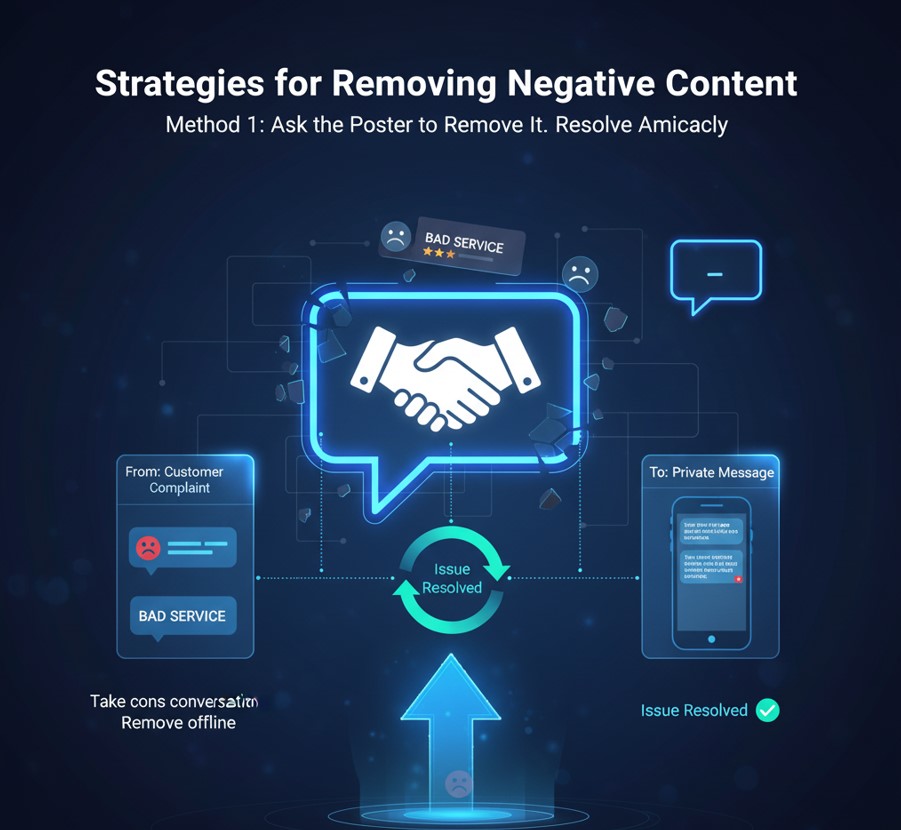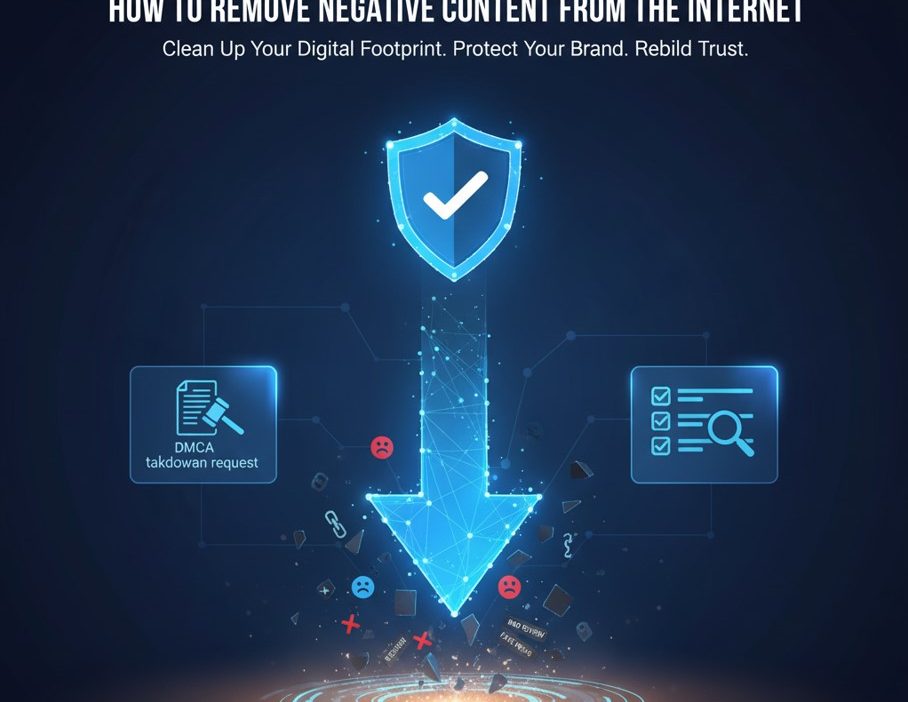A single negative search result can have a significant impact on your business. It can deter potential customers, damage your brand’s credibility, and ultimately affect your bottom line. While it might feel like what’s on the internet is permanent, you have more power than you think. Removing or reducing the visibility of negative content is possible, but it requires a strategic and persistent approach.
This guide is designed for business owners who are facing the challenge of unwanted online content. We’ll walk you through the practical steps you can take to clean up your digital footprint, from direct removal requests to more advanced reputation management strategies. Understanding these options will help you protect your brand and maintain a positive online presence.
The goal isn’t just to react to negative content but to build a resilient online reputation that can withstand future challenges. By the end of this post, you’ll have a clear roadmap for tackling negative search results and a proactive strategy for long-term brand management.
First, Assess the Damage
Before you can take action, you need a complete picture of the situation. The first step is to thoroughly assess the negative content and understand its potential impact on your business.
Identify and Document Everything
Start by conducting a comprehensive search for your business name, your name, and any key products or services you offer. Don’t just stop at the first page of Google; dig deeper into the search results.
Use a variety of search engines, including Google, Bing, and DuckDuckGo, as results can differ. Set up Google Alerts for your business name to be notified of any new mentions.
As you find negative content, document it in a spreadsheet. For each piece of content, record the following:
- URL: The direct link to the page.
- Website/Platform: Where the content is hosted (e.g., Yelp, a blog, a news site, Facebook).
- Content Type: Is it a review, a blog post, a forum comment, or a news article?
- Summary: A brief overview of the negative claim.
- Screenshot: A visual record of the content.
- Visibility: Where does it rank in search results for key terms?
This documentation will be crucial for tracking your progress and organizing your removal efforts.
Analyze the Content’s Impact
Once you have a list of negative items, analyze each one to determine its severity. Not all negative content is created equal. Ask yourself these questions:
- Is it credible? A well-written article on a reputable news site carries more weight than an anonymous comment on an obscure forum.
- How visible is it? Content on the first page of Google for your brand name is a high priority. A negative comment buried on page 10 is less urgent.
- What is the tone? Is it a balanced critique or a malicious attack?
- Is it factual? Does the content contain verifiable falsehoods, or is it a matter of opinion? Defamatory content (false statements presented as fact that harm your reputation) often has a clearer path to removal.
Prioritize the content that poses the most significant threat to your business. This will typically be highly visible, credible, and defamatory content.
Strategies for Removing Negative Content
With your assessment complete, you can now explore your options for removal. These strategies range from direct requests to legal action. It’s often best to start with the simplest and least confrontational method first.

Method 1: Ask the Poster to Remove It
The most direct approach is to contact the person who posted the content and politely ask them to take it down. This is most effective when you have a good relationship with the person or if the issue was a misunderstanding that has since been resolved.
- When to use it: Ideal for negative reviews from customers whose issues you have resolved, or for content posted by former employees or partners with whom you are on amicable terms.
- How to do it: Reach out privately via email or direct message. Be polite, professional, and empathetic. Acknowledge their complaint and explain the steps you’ve taken to address it. Avoid being defensive or aggressive, as this can backfire.
For example, you could say: “Hi [Name], I’m sorry to see you had a negative experience with our service. We’ve since updated our process to prevent this from happening again. Since we’ve resolved the issue, would you be willing to update or remove your review? We’d greatly appreciate it.”
Method 2: Request Removal from the Website Owner
If you can’t contact the original poster or they refuse to remove the content, your next step is to contact the owner of the website where it’s hosted. This could be a blog owner, a forum administrator, or a review platform’s support team.
Most websites have terms of service or content policies that prohibit certain types of content, such as:
- Defamation: False statements that harm a reputation.
- Copyright infringement: Using your intellectual property without permission.
- Harassment or hate speech: Personal attacks or abusive language.
- Private information: Publishing sensitive data like your home address or financial details.
Review the website’s policies and see if the negative content violates any of them. If it does, you have a strong case for removal.
- When to use it: When the content violates the platform’s rules. This is common for fake reviews, personal attacks, and content containing private information.
- How to do it: Look for a “Contact Us,” “Report Abuse,” or “Help” link on the website. Submit a detailed removal request, clearly explaining which policy has been violated and providing evidence to support your claim. Be specific and link directly to the offending content.
Method 3: Use Google’s Removal Tools
Google is a search engine, not a publisher. This means it generally won’t remove content from the internet itself. However, it does have policies that allow it to de-index certain types of content from its search results, making it virtually invisible.
Google may remove content from its search results if it falls into specific categories, including:
- Sensitive personal information: Government ID numbers, bank account details, and medical records.
- Non-consensual explicit images: Also known as “revenge porn.”
- Copyright infringement: Content that violates the Digital Millennium Copyright Act (DMCA).
- Outdated or irrelevant content (in some jurisdictions): Known as the “Right to be Forgotten,” this is primarily applicable in Europe under GDPR.
- When to use it: When the content falls into one of Google’s specific removal categories. This is not a solution for general negative reviews or opinions.
- How to do it: Use the Google Search Console removal tool to submit a request. You will need to provide the URL of the page and a reason for the removal request based on Google’s policies. Be prepared to provide documentation to support your claim.
Method 4: Take Legal Action
If the above methods fail and the content is causing significant harm to your business, you may need to consider legal action. This is the most complex and expensive option and should be treated as a last resort.
Consult with an attorney who specializes in internet law or defamation. They can help you understand your legal options, which may include:
- Sending a cease and desist letter: A formal letter from your attorney demanding that the content be removed. This often shows you are serious and can prompt action without going to court.
- Filing a defamation lawsuit: If the content is false and has caused quantifiable financial damage to your business, you can sue the poster for damages.
- Obtaining a court order: If you win a lawsuit, the court can issue an order compelling the website owner to remove the content. This court order can then be submitted to Google and other search engines to have the content de-indexed.
- When to use it: For severe cases of defamation, slander, or libel that are causing demonstrable financial harm.
- How to do it: Engage a qualified attorney to guide you through the legal process.
When Removal Isn’t an Option: Suppression and Reputation Management
Sometimes, negative content cannot be removed. It might not violate any terms of service, it could be a legitimate (though harsh) opinion, or it might be published on a news site protected by freedom of speech. In these cases, the best strategy is suppression.
Suppression involves creating and promoting positive content to push the negative content down in search engine rankings. The goal is to fill the first few pages of search results with positive or neutral information about your brand, making the negative items much harder to find.
Build a Strong Digital Footprint
Create a network of online properties that you control. This gives you multiple platforms to publish positive content. Key assets include:
- Your company website and blog: This should be the cornerstone of your online presence.
- Social media profiles: Create and maintain active profiles on LinkedIn, Facebook, X (formerly Twitter), Instagram, and any other platforms relevant to your industry.
- Business listings: Claim your profiles on Google Business Profile, Yelp, and other relevant review sites.
Create and Promote Positive Content
Consistently publish high-quality, SEO-optimized content across your online properties. This content will compete with the negative results for visibility in search engines.
- Blog Posts: Write articles that showcase your expertise, share company news, and highlight customer success stories.
- Press Releases: Announce new products, partnerships, or company milestones.
- Positive Customer Reviews: Actively encourage satisfied customers to leave reviews on key platforms. Respond to all reviews, both positive and negative, to show that you are engaged and value feedback.
- Guest Posts: Write for other reputable blogs in your industry to build authority and generate positive mentions.
The key to suppression is consistency. It’s a long-term strategy that requires a sustained effort to build and maintain a positive online presence.
Charting Your Path Forward
Dealing with negative online content can be a stressful and time-consuming process, but it’s a manageable one. By starting with a thorough assessment, exploring all removal options systematically, and committing to a long-term reputation management strategy, you can protect your brand’s image.
Remember to prioritize your efforts based on the severity and visibility of the content. Start with direct and polite requests before escalating to more formal methods. If removal proves impossible, focus your energy on a proactive suppression strategy by creating a wealth of positive content that defines your brand on your own terms. Your online reputation is one of your most valuable assets—invest in it accordingly.
Learn more about: What is Customer Relationship Management? A Complete Guide





